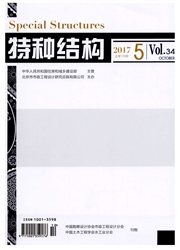

 中文摘要:
中文摘要:
本文首先简述了应用线性滤波法中的自回归模型(AR模型)模拟出给定风速功率谱的风速时程序列,并验证其与目标谱的一致性,再通过规范公式推导脉动风载与风速之间的关系,从而得到作用在各节点的脉动风荷载时程样本。本文以某羊角形输电塔为原型进行了模拟计算分析,用有限元分析软件ANSYS建立了有限元模型,并用MATLAB生成塔架迎风面各节点上的风荷载时程信号作为动力输入。利用ANSYS对结构进行了模态分析,结果显示结构的基本模态为平面振动,但是同时具有扭转模态和局部振动模态;对此输电塔结构进行了平均风作用下的静力分析,同时,基于ANSYS时程分析方法计算了结构在一般风荷载作用下的风振响应。结果表明,在考虑一般风荷载作用的情况下,输电塔在顶部出现最大的位移和加速度响应,而在底部出现最大的轴力响应,但由于本文输电塔结构杆件的变截面设计,最大的应力出现在约1/3高处的杆件上。相对于平均风的作用,结构响应在一般风荷载下呈现出明显的动力放大效应。
 英文摘要:
英文摘要:
In this paper, Autoregressive Model (AR) is firstly introduced to simulate wind speed time series with a given wind speed spectrum. The agreement of the spectrum of the simulated wind speed time series to the target spec- trum is also verified. The relationship between wind load and wind speed is also derived according to the related Chi- nese codes. Samples of fluctuating wind load on the nodes of a structure are obtained. Simulations are applied for a transmission tower. ANSYS is used to build the FEM model. Wind load time history series are obtained using MATLAB as the input. Through modal analysis, it can be seen that the basic modes of the structure are plane vibration modes. Torsional vibration modes and local vibration modes also take important roles. Meanwhile, time history analysis is ap- plied to analyze the structural response under dynamic wind loads. Results show that, under fluctuating wind loads, the transmission tower has the largest displacements and accelerations at the top, while has the largest elemental axial force at the bottom. However, due to the application of different elemental section sizes, the largest stress does not ap- pear at the bottom. The analysis also shows that compare with the responses under mean wind pressure, those under general wind show the significant dynamic amplification.
 同期刊论文项目
同期刊论文项目
 同项目期刊论文
同项目期刊论文
 期刊信息
期刊信息
